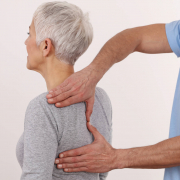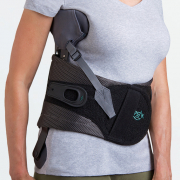Scoliosis? It can be treated in adulthood, too
The young scoliosis patients who come to us for conservative treatment often have parents (one or both) affected by scoliosis. Some of these parents received exercise-based and/or bracing treatment in adolescence; some never got any treatment at all, while others even discovered the condition late on, after reaching adulthood. Often, they are completely convinced that there is nothing more to be done for their scoliosis! But nothing could be further from the truth!
For these adults, the first obstacle to overcome is precisely this unwillingness to do something about their condition: some are reluctant to face up to a problem that has caused them suffering in the past, some believe there are no solutions, and others give priority, above all, to their child’s care needs.
These attitudes are entirely understandable, but unfortunately burying one’s head in the sand simply has the effect of increasing the risks as time goes by. It must be understood that if scoliosis is getting worse, this is not a momentary problem — it is a situation that could lead to more marked symptoms in the future, such as pain and back problems.
When scoliosis worsens, the spine may start to bend laterally following the curve direction, creating a so-called Tower of Pisa effect. What is more, this can be accompanied by forward bending of the upper body. As well as having negative aesthetic consequences, all this can seriously impair the individual’s quality of life.
Specific self-correction exercises are an excellent way of dealing with a worsening situation like this. It is worth remembering that a worsening of scoliosis in adulthood is not necessarily accompanied by pain; however, if pain does occur, the exercises should target both problems. We often come across adults who say they realised there was “something wrong” when looking at themselves in the mirror.
There are a number of possible signs to look out for: asymmetry of the hips, skirts or trousers that don’t hang right, asymmetry of the shoulders, a more pronounced hump, the perception of having lost a few centimetres in height. All these are red flags that should prompt you to seek the advice of a spine specialist.
Because, when it comes to scoliosis, it is definitely best to act in a timely fashion, taking steps to find out whether something is changing or if everything is stable.
Various studies have shown that scoliosis measuring under 30° at the end of growth normally remains stable over time, even during adulthood, while curves greater than 50° almost always tend to worsen [1]. Obviously, there are exceptions to both these “rules”.
We do not know for sure exactly what happens in the case of curves measuring between 30° and 50°; we only know that, in general, the risk of deterioration increases as curves become more prominent.
In adult cases, it is important to have the medical and radiographic check-ups prescribed by the doctor. At ISICO we follow protocols that are based mainly on the severity of the curve, recommending the following:
– for curves with a Cobb angle of less than 20 degrees that have been treated during adolescence, a medical check-up every 4-5 years;
– for curves with a Cobb angle of between 20 and 29 degrees, a medical check-up every 2-3 years;
– for curves with a Cobb angle of between 30 and 44 degrees, a medical check-up every 1-2 years;
– for curves with a Cobb angle greater than 45 degrees, an annual check-up.
These recommendations aside, the doctor can give different indications, based other factors, such as the patient’s age and how stable the curve has proved to be in the past.
As for X-rays, the antero-posterior view is recommended if there has been a worsening of the hump.
When spine specialists measure X-rays of adult patients with scoliosis, they know that what they are seeing represents the sum of two components: the structural deformity of the spine and the patient’s posture.
In adults, there is little that can be done to alter the bone component (structural deformity), given that the individual has finished growing. However, we can certainly intervene on the postural part, teaching our patients how to support the weight of their trunk under the effect of gravity.
One of the main aims of the specific exercises we prescribe at ISICO is to help patients learn the technique of ACTIVE SELF-CORRECTION. This refers to a series of movements that patients are taught as a means of realigning their spine as much as possible, so as to counteract its tendency to collapse on the side of the curve; they are also encouraged to try and maintain much of this correction in their everyday activities. In this way, patients have a means of reducing, albeit temporarily, their curve by a few degrees, and possibly also the imbalance of the trunk that it causes.
In short, given the risk of a slow deterioration of the condition, it is important to have regular check-ups, for preventive purposes [2].
Finally, one last crucial piece of advice. Always make sure you get regular physical exercise, appropriate for your age and physical condition. There is no one sport or activity that is better than others: the choice depends entirely on the individual patient’s situation.
If, in addition to doing sport and physical exercise, you also need to do targeted exercises for the spine, contact a spine specialist, who will draw up an ad hoc exercise plan for you.
[1 ] 2016 SOSORT guidelines: orthopaedic and rehabilitation treatment of idiopathic scoliosis during growth. Negrini et al. Scoliosis Spinal Disord 2018
[2] Natural history of progressive adult scoliosis. Marty-Poumarat et al. Spine 2007



